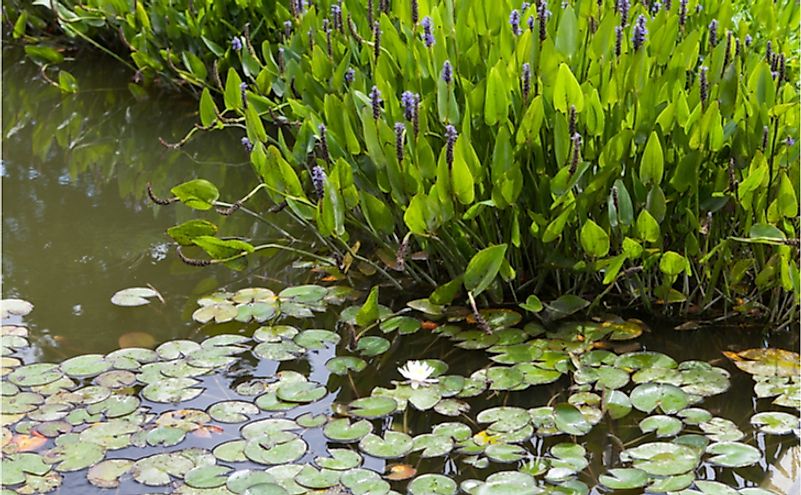What Are The Different Types Of Aquatic Plants?

Aquatic plants are plants that have adapted to surviving in aquatic environments. Also known as macrophytes or hydrophytes, aquatic plants grow on or in water and are either submerged, emergent or floating. They provide cover and food for aquatic life, produce oxygen, and can also be a food source for certain terrestrial animals. Aquatic plants require particular adaptations to grow on the water's surface and cannot survive in terrestrial environments. For example, their stems are spongy with air spaces to keep the plant vertical or floating above the water. Aquatic plants have developed in different plant families and can be angiosperms or ferns. Seaweeds are not typically classified as aquatic plants since they are multicellular algae. Some aquatic plants are capable of growing in saltwater, saline, or brackish environments. Seagrasses are the only angiosperms that can grow while completely submerged in seawater. Most aquatic plants reproduce by flowering, while others depend on forms of asexual reproduction through turions, rhizomes, and fragments. The Amazon water lily is among the largest aquatic plants, while the minute duckweed is one of the smallest. Other familiar aquatic plants include water lilies, water hyacinth, lotus, and floating heart. Factors that affect the distribution of aquatic plants include the depth and duration of floods, distribution, and abundance of nutrients, salinity, grazing, and disturbance by waves.
Characteristics Of Aquatic Plants
The characteristics of aquatic plants vary depending on the type of plant and the aquatic environment in which it grows. However, some features are universal. For example, they utilize fewer resources to support their leaves and stems because they naturally stay afloat, and they lack the cuticle layer that prevents water loss since there is no need to retain moisture. Aquatic plants also lack the xylem to transport water since their entire bodies are submerged. The leaves of emersed plants float on the water surface to access sunlight and air, while the roots float in the water. Aquatic plants remain green throughout the year and do not drop their leaves since they have a sufficient supply of nutrients and water.
Types of Aquatic Plants
Emergent Plants
Emergent plants grow in water, but part of the plant remains above the water's surface. This adaptation allows the leaves to photosynthesize more efficiently, providing more oxygen and nutrients to submerged parts of the plant. In most cases, the leaves, flowers, and other reproductive parts float above the surface to enable pollination by insects and wind. There are numerous species of emergent aquatic plants, including the reed, wild rice, and flowering rush. They can grow in fens and ponds, but do not thrive in these environments due to competition from other aquatic plants. The purple loosestrife is an example of an emergent plant that can also thrive in minimal water, such as fens and damp ground.
Floating-Leaved
Floating-leaved aquatic plants have roots that are attached to the bottom of the body of water in which they grow, but their leaves float on the water's surface. They are characterized by broad leaves, and examples of floating-leaved plants include pondweeds and water lilies.
Submerged
Submerged aquatic plants grow entirely underwater. They can either have roots that are attached to the bottom of the body of water in which they grow or have no root system at all. Some submerged plants remain attached to other aquatic plants.
Free-Floating
Free-floating plants remain suspended on the water's surface. They have broad leaves and stems that attach to neighboring plants to create a dense net of free-floating plants. Free-floating aquatic plants are not attached to the bottom of the body of water in which they grow, and are therefore easily moved by wind and waves. Examples of free-floating aquatic plants include the Nile cabbage, water cabbage, and water lettuce.
Functions of Aquatic Plants in the Ecosystem
Aquatic plants absorb dissolved nutrients from the water and act as purifiers. They are often planted in artificial lakes and ponds to help reduce the toxicity of water and the organisms that live in the water. They also reduce erosion by slowing down the movement of water. Some aquatic plants such as wild rice, water caltrop, and Indian lotus are a food source for humans and animals. Aquatic plants can also serve as an indicator of water quality. For example, a thriving aquatic plant population indicates good or improving water quality, while a declining population indicates contamination or pollution. Contamination may result from excessive use of herbicides, turbidity, or salinization.











